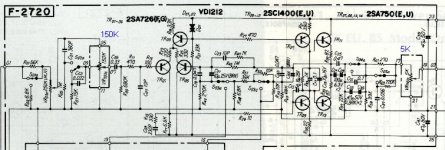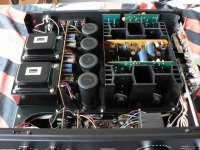I haven't seen this previously but my Sansui AU-717 has a quad gang pot with 150Kx2 + 5Kx2. See the schematic attached with the 150K coming first and the 5K last prior to the power amp.
Any advantages with this arrangement as I know the AU-517 only uses the 150Kx2 at the same location? I'm just curious.
Any advantages with this arrangement as I know the AU-517 only uses the 150Kx2 at the same location? I'm just curious.
Attachments
It increases the signal to noise ratio at volume pot settings below the maximum, it was quite commonly used in higher positined products in the 70's and early 80's. Normally, the power amp would fully amplify the preamp noise even when the volume setting is minimal, in this manner, the output of the preamp is also attenuated, making the total apparent gain of the combination smaller at lower volume settings, therefore there is less noise. The pots have a slightly different taper in the case of the AU517 and 717 because of this, to produce similar attenuation vs. pot position.
Because of loudness Rabbitz.
This tape, into center resistance, allow the loudness contour actuate into low levels.
The Loudness compensates human ear losses into bass when you play into a very low volume...some loudness also increases a little into high frequencies..but mainly into low end.
Because of this tape...when you play your equipment loud.... swithing the loudness control on and off you will not perceive differences in sonics.
Equipments that do not have this tape works with the loudness engaged all time long....no good that, because will start to distort very soon...bass reproduction uses almost 60 percent of the entire power.... as soon reaches the limit will clip.
Thank you by the pictures you sent me about your Sansui Rabbitz... amazing new unit... looks you got it out from the box last week!
regards,
Carlos
This tape, into center resistance, allow the loudness contour actuate into low levels.
The Loudness compensates human ear losses into bass when you play into a very low volume...some loudness also increases a little into high frequencies..but mainly into low end.
Because of this tape...when you play your equipment loud.... swithing the loudness control on and off you will not perceive differences in sonics.
Equipments that do not have this tape works with the loudness engaged all time long....no good that, because will start to distort very soon...bass reproduction uses almost 60 percent of the entire power.... as soon reaches the limit will clip.
Thank you by the pictures you sent me about your Sansui Rabbitz... amazing new unit... looks you got it out from the box last week!
regards,
Carlos
Attachments
Notice on the PCB how Sansui printed an image of the copper traces in green, on top of the PCB for easy maintenance....
I saw a lovely big Sansui killed at last year's new year party.... some idiot put a plastic A4 folder on top of it while it was blasting away... blocking the vents....


I saw a lovely big Sansui killed at last year's new year party.... some idiot put a plastic A4 folder on top of it while it was blasting away... blocking the vents....



Man!.... you could see the idiot make that?
This was terrible!
I would like to tell him a better place to him to introduce the folder.... unless, he deserves!
Yeah!....you understood.... can introduce into a shelf compartment.
A real pitty.... those units were very good.
regards,
Carlos
This was terrible!
I would like to tell him a better place to him to introduce the folder.... unless, he deserves!
Yeah!....you understood.... can introduce into a shelf compartment.
A real pitty.... those units were very good.
regards,
Carlos
rabbitz said:Thanks guys.
I lusted over one of these in the late 70's.... finally have one now, 30 years on, along with a matching TU-417 tuner.... a great era for Sansui before the company fell apart. What a shame.
The 717 is an excellent amp, especially with a minimum of tweaking. The small electrolytics can now be replaced with foil caps, and a change of output transistors will help with difficult loads (because of better beta linearity). Some judicious changes in the semiconductors in the line amp will also lower the noise floor.
Reliability enhancements include scraping off the notorious Sansui glue that holds some larger components but tends to corrode some of them or smaller components it splashed over, particulairy zeners on the regulator board. On the power amp boards there are two 150 ohm (IIRC) resistors each that should be changed from 0.5 to 1W units. The dual layer diodes used for current references are notorious for going bad, they can be replaced with 1N4148 in series, or in some cases by a well chosen LED. Together with a re-cap, this will make the whole thing a great and very reliable amp for the next 30 years
Hi Ilimzn,
I completely agree with you, its a wonderful amp except for the deadly glue. Recently I've acquired an AU-717 with one problematic channel. The problem turned out to be shorted transistor in preamplifier power supply. After fixing this problem another problem showed up. It takes very long time (around 10 mins) for the speaker protection relay to actuate. Changed the capaitors in the relay driver circuit without success. The problem is one of channel output has huge sliding dc offset that eventually come within the limits after sometime. Replaced all the caps in that channel without any success. Then started replacing the semiconductors with the ones from the good channel. No success yet. I found some corrossion of resistors because of the glue, measured the resistor they seemed to be fine. But replaced the corroded feedback resistor, Vioala!!! the problem solved. Pretty unusual problem. So later replaced the caps in preamp boards and power amp boards. After capacitor replacement it lost some of its 'vintage' sound, but it sounds fine with tight bass and accurate vocals. I urge people to keep the replaced old caps in the signal path, if they want the vintage like sound they may need to put them back. Surprising buts true. I've observed this effect in many old amps after replacing the caps. That is the reason I am hesitant to replace the caps in the signal path of my Luxman R-1120 receiver.
Coming to the point, Ilimzn can you specifically tell which semiconductors should be replaced by which modern equivalents? Also this amp uses 2sk97 dual FET in its differential input stage, I have couple of latest 2sk389BL dual FETs if I replace the older ones with this newer ones will it make any difference in sound? Again I appreciate if you give clear recommendation on parts replacement for this amp?
Thanks,
routhun
I completely agree with you, its a wonderful amp except for the deadly glue. Recently I've acquired an AU-717 with one problematic channel. The problem turned out to be shorted transistor in preamplifier power supply. After fixing this problem another problem showed up. It takes very long time (around 10 mins) for the speaker protection relay to actuate. Changed the capaitors in the relay driver circuit without success. The problem is one of channel output has huge sliding dc offset that eventually come within the limits after sometime. Replaced all the caps in that channel without any success. Then started replacing the semiconductors with the ones from the good channel. No success yet. I found some corrossion of resistors because of the glue, measured the resistor they seemed to be fine. But replaced the corroded feedback resistor, Vioala!!! the problem solved. Pretty unusual problem. So later replaced the caps in preamp boards and power amp boards. After capacitor replacement it lost some of its 'vintage' sound, but it sounds fine with tight bass and accurate vocals. I urge people to keep the replaced old caps in the signal path, if they want the vintage like sound they may need to put them back. Surprising buts true. I've observed this effect in many old amps after replacing the caps. That is the reason I am hesitant to replace the caps in the signal path of my Luxman R-1120 receiver.
Coming to the point, Ilimzn can you specifically tell which semiconductors should be replaced by which modern equivalents? Also this amp uses 2sk97 dual FET in its differential input stage, I have couple of latest 2sk389BL dual FETs if I replace the older ones with this newer ones will it make any difference in sound? Again I appreciate if you give clear recommendation on parts replacement for this amp?
Thanks,
routhun
I found my unit was very sensitive to changes to the flameproof resistors before the outputs... I actualy have to work on it again...
I recapped it way back, then started swapping out old carbon comps etc... eventualy it had quite a bit of crackly distortion on the one channel after I swapped that resistor... decided I will rather find out how these things work than just swap it back...
I recapped it way back, then started swapping out old carbon comps etc... eventualy it had quite a bit of crackly distortion on the one channel after I swapped that resistor... decided I will rather find out how these things work than just swap it back...
- Status
- This old topic is closed. If you want to reopen this topic, contact a moderator using the "Report Post" button.
- Home
- Amplifiers
- Solid State
- Strange pot in Sansui AU-717

